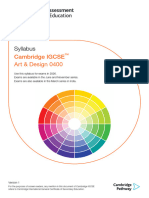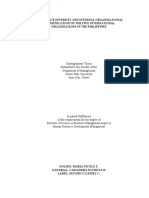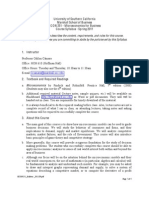Unit 8 Syllabus: Surface Area & Volume: Date - Period
Uploaded by
GoldycrystalUnit 8 Syllabus: Surface Area & Volume: Date - Period
Uploaded by
GoldycrystalDate _________
Period_________
Unit 8 Syllabus: Surface Area & Volume
Day 1 Topic Space Figures and Cross Sections
Surface Area and Volume of Spheres
Surface Area of Prisms and Cylinders Surface Area of Pyramids and Cones
Volumes of Prisms and Cylinders Volumes of Pyramids and Cones
Review
Quiz
Areas and Volumes of Similar Solids
Review
Review Sheets/Study
Test
To Be Determined
Date _________
Period_________
Unit 8, Day 1: Space Figures & Cross Sections (S 11-1 )
1. Use your book, your friends, and your brilliant teacher to define and fill in the following a) Polyhedron:; b) Face: c) Edge: d) Vertex: e) Eulers Formula:
Use Eulers Formula to find the missing number. 1) Faces: 5 Edges: Vertices: 5 2) Faces: Edges: 9 Vertices: 9 3) Faces: 8 Edges: 18 Vertices:
Using the demonstration given on a cross section, describe it below.
Formal Definition (cross section):
Determine the cross section of each figure below. A) B) C)
Using the demonstration given, describe what is meant by the net of a polyhedron.
Match each polyhedron with its net below. 1) 2) 3) 4)
A.
B.
C.
D.
Explanation of Figures: Prism, Cylinder, Pyramid, Cone, Sphere
Date _________
Period_________
Formula Sheet Volume and Surface Area (Unit 8 )
L E G E N D
B = area of base P = perimeter of base C = circumference of base l = slant height of polyhedron h = height of polyhedron 4
Date _________
Period_________
U8D2 Volume and Surface Area of Spheres
2. A sphere is a set of points in space ___equidistant_________ from a point called the center.
Define the following: Radius: a segment that has one endpoint at the center and the other endpoint on the sphere Diameter. A segment passing through the center with endpoints on the sphere Great Circle: if the center of a circle is also the center of the sphere, then its a great circle. Hemisphere: a half sphere - a great circle divides a sphere into two hemispheres.
From your formula Sheet
Example: What is the volume and surface area of a sphere with radius 5?
V =
4 4 500 3 = ( 5) = (125) 3 3 3
= SA 4= ( 5 ) 4= ( 25 ) 100
2
1. Find the volume and surface area. 14 in.
2. Find the volume and surface area.
12 in.
3. The volume of a sphere is 1200 ft3, what is the radius? What is the surface area?
4. The circumference of a basketball is approximately 75 cm, how much leather does it take to make the basketball?
5. An ice cream cone 6 inches tall, with a 2 inch radius is completely filled, including a perfect hemisphere sitting on top. How much ice cream is there?
Date _________
Period_________
U8D3: Surface Area Prisms, Cylinders, Cones, Pyramids
1. Describe, compare, and contrast the words lateral area, base area, and surface area
2. Which figures have 2 bases and which figures have only 1 base?
3. What does the letter represent on your formula sheet? Name the word & describe it.
4. The Cylinder and Prism are the same except the base is a circle instead of a polygon.
Area of Base
Circle = r 2
1 bh 2 Rectangle = b h 1 Polygon = a p 2 Triangle = Perimeter = add up all sides LA = Ph = Perimeter height SA = Ph + 2 B
Length around the base Lateral Area Surface Area
Circumference = 2 r LA = Ch = 2 rh SA = LA + 2B = 2 rh + 2 r 2
5. The pyramid and the cone are the same, except the base is a circle instead of a polygon.
Area of Base
Circle = r 2
1 bh 2 Rectangle = b h 1 Polygon = a p 2
Triangle = Perimeter = add up all sides LA = 1 Pl = Perimeter slant-height 2
Length around the base Lateral Area Surface Area
Circumference = 2 r LA = 1 2 rl = rl 2
SA = LA + B = rl + r 2
1 SA = B + Pl 2
1. Right Rectangular Prism
18
4 12
B = _______, h = ________, P = __________
LA = _________, SA = ________
2. Right Square Pyramid
B = ______, h = ______, P = _______, l = ______ 3. Right Cone
LA = ________, SA = _______
B = ______, h = ______, C = _______, l = ______ 4. Right Cylinder
LA = ________, SA = _______
B = _______, h = ________, C = __________
LA = _________, SA = ________
What are the formulas for the surface area of a prism, cylinder, pyramid and cone? Compare and contrast them 9
Date _________
Period_________
U8D4: Volumes Prisms, Cylinders, Cones, Pyramids
Notes presented on powerpoint. All formulas are listed on your formula sheet
Date _________
Period_________
U8D5: Review for Day 6 Quiz
Racecar game continued. You may make a note card for tomorrows quiz!
10
Date _________
Period_________
Unit 8, Day 7: Areas/Volumes of Similar Solids (S 11-7)
1. In the space below, describe and draw a pair of similar polygons
Describe and draw similar solids
2. Describe a one-dimensional measurement
3. Describe a two-dimensional measurement
4. Describe a three-dimensional measurement
5. Fill in the chart below by naming each variable from your formulas sheet, and determining what dimension it is. Variable V B h P SA C l r Name Dimension
11
6. Reminder: The ___________________ ________________ of two similar figures gives the ratio of the corresponding linear (1) dimensions of the figures. 7. Refer to the chart from the warm up to determine what dimension each variable is If the similarity ratio of two similar solids is given a:b, then (1) the ratio of their corresponding (surface) areas (2 dimensions) is (2) the ratio of their volumes (3 dimensions) is
8. Example: Two similar cones have radii in the ratio of 4:5. a) What is the ratio of their heights?
b) What is the ratio of their surface areas?
c) What is the ratio of their volumes?
d) The smaller cone has a volume of 42. What is the volume of the larger cone?
9. The ratio of the surface areas of two similar prisms is 9:16. What is the ratio of their volumes?
12
10. Are the following polygons similar? 16 in. 12 in. 12 in. 9 in.
11. Pyramid 1: SA = 25 cm2, V = ________ Pyramid 2: SA = 36 cm2, V = 216 cm3
12. The ratio of the volumes of two similar solids is 125:27. What is the ratio of their surface areas? What is the ratio of their heights?
13. The volumes of two similar cylinders is 125 and 64 . What is their similar ratio?
14. Closure: Describe the connection between the similarity ratio, the ratio of areas and the ratio of volumes for two similar solids.
13
Date _________
Period_________
Unit 8 Day 8: Test Review Packet
1. Prisms. Find the volume and surface of a prism with an equilateral triangular base of side lengths 4, and a height of 6.
2. Cylinder: What is the lateral area of a cylinder with a volume of 288 and a height of 8?
3. Pyramid: A pyramid with a square base has a height of 10 and a slant height of 26. What is the volume and surface area of the pyramid?
14
4. Cone: A cone has a radius of cone?
3 and a volume of 12 . What is the slant height of the
5. Spheres: A sphere has a volume of 36 . What is the surface area of the sphere?
6. Similar Solids: The similarity ratio of two cones is 4:5. What is the ratio of their surface areas? What is the ratio of their volumes? If the surface area of the smaller cone is 64, what is the surface area of the larger cone?
15
7. Describe the cross section of the figure shown.
8. Find the Lateral Area, Surface Area, and Volume of the figures shown below.
LA = ________, SA = _________, V = _________
LA = ________, SA = _________, V = _________
9. Find the Lateral Area, Surface Area, and Volume of the figures shown below.
LA = ________, SA = _________, V = _________
LA = ________, SA = _________, V = _________ 16
10. Find the volume of a right pyramid with a regular hexagonal base (sides lengths 6) and a height of 9.
11. The pairs of figures shown below are similar, find the similarity ratio.
12.
a)
b)
13. A cone and a cylinder have the same radius and the same volume. If the height of the cone is 18 inches, what is the height of the cylinder?
17
You might also like
- Evening Classes at Grove Academy in Broughty Ferry, Dundee For The Autumn Term 2015100% (1)Evening Classes at Grove Academy in Broughty Ferry, Dundee For The Autumn Term 20152 pages
- 81-The-Characteristic-properties-of-acids-and-bases-Topic-Booklet-1-CIE-IGCSE-ChemistryNo ratings yet81-The-Characteristic-properties-of-acids-and-bases-Topic-Booklet-1-CIE-IGCSE-Chemistry11 pages
- Cambridge (CIE) IGCSE Economics: 2.7 Price Elasticity of Demand (PED)No ratings yetCambridge (CIE) IGCSE Economics: 2.7 Price Elasticity of Demand (PED)9 pages
- 7 2 Preparation of Salts PVXkVqzz9cBMBDXfNo ratings yet7 2 Preparation of Salts PVXkVqzz9cBMBDXf36 pages
- Science Practice Questions For Term End Exams 2024No ratings yetScience Practice Questions For Term End Exams 202423 pages
- PPT3 - Cambridge - IX - Chem - Unit17 - Chemistry of Our EnvironmentNo ratings yetPPT3 - Cambridge - IX - Chem - Unit17 - Chemistry of Our Environment17 pages
- Cambridge IGCSE: 0417/12 Information and Communication TechnologyNo ratings yetCambridge IGCSE: 0417/12 Information and Communication Technology20 pages
- 3-7-firms-costs-revenue-and-objectives-69nFsNbZ6nYBZkM5No ratings yet3-7-firms-costs-revenue-and-objectives-69nFsNbZ6nYBZkM58 pages
- WORKSHEET - Reactivity & Rate of Chemical ReactionNo ratings yetWORKSHEET - Reactivity & Rate of Chemical Reaction5 pages
- PPT1 - Cambridge - IX - Chem - Unit17 - Chemistry of Our EnvironmentNo ratings yetPPT1 - Cambridge - IX - Chem - Unit17 - Chemistry of Our Environment19 pages
- 12 Experimental Techniques and Chemical AnalysisNo ratings yet12 Experimental Techniques and Chemical Analysis22 pages
- 9 1 Properties Uses and Alloys of Metals YzVf2fMWcYVxZDKPNo ratings yet9 1 Properties Uses and Alloys of Metals YzVf2fMWcYVxZDKP34 pages
- APznzaYmSLD5xtQQwd7h0CcmEjkaC1n yfqyuwDfFmsV7Cupc1Oz27UTFiNps8mMlKVxW48ndYZTnSGD9Lnl7DkdslrvxCG6gc0GOYZ2G7-FXwvvZeERZvmg9urNqkJrKxbW7vJCBIJpWzvW2qF6iv IdcNcLMuxaEpx2MQWW6eb9g7f-7TauIrVteRmpbZyFzoxVNo ratings yetAPznzaYmSLD5xtQQwd7h0CcmEjkaC1n yfqyuwDfFmsV7Cupc1Oz27UTFiNps8mMlKVxW48ndYZTnSGD9Lnl7DkdslrvxCG6gc0GOYZ2G7-FXwvvZeERZvmg9urNqkJrKxbW7vJCBIJpWzvW2qF6iv IdcNcLMuxaEpx2MQWW6eb9g7f-7TauIrVteRmpbZyFzoxV5 pages
- Unit 20. Biotechnology and Genetic ModificationNo ratings yetUnit 20. Biotechnology and Genetic Modification19 pages
- Unit 3. Movement Into and Out of The Cells.No ratings yetUnit 3. Movement Into and Out of The Cells.20 pages
- 11-Gas Exchange in Humans-Qp Igcse-Cie-BiologyNo ratings yet11-Gas Exchange in Humans-Qp Igcse-Cie-Biology14 pages
- 17.7-Energy Work Power-Cie Igcse Physics Ext-Theory-Qp CombiNo ratings yet17.7-Energy Work Power-Cie Igcse Physics Ext-Theory-Qp Combi10 pages
- Workssheets - PHOTOSYNTHESIS - Cambridge Checkpoint PDF Leaf StomaNo ratings yetWorkssheets - PHOTOSYNTHESIS - Cambridge Checkpoint PDF Leaf Stoma1 page
- 41 Stoichiometry Topic Booklet 2 CIE IGCSE CHNo ratings yet41 Stoichiometry Topic Booklet 2 CIE IGCSE CH8 pages
- 2022 - 17 Bearing and Scale Drawing Checkpoint - Sec - 1 Mathematics - SolvedNo ratings yet2022 - 17 Bearing and Scale Drawing Checkpoint - Sec - 1 Mathematics - Solved6 pages
- 2.10 - 2.11 - Market Failure and Government Intervention - IGCSE AIDNo ratings yet2.10 - 2.11 - Market Failure and Government Intervention - IGCSE AID5 pages
- Re - Write The Sentences Using Capital Letters and Full Stop at Appropriate PlacesNo ratings yetRe - Write The Sentences Using Capital Letters and Full Stop at Appropriate Places1 page
- Week 1 Week 1 Week 1 Week 1: Neighbour Neighbour Neighbour NeighbourNo ratings yetWeek 1 Week 1 Week 1 Week 1: Neighbour Neighbour Neighbour Neighbour1 page
- Workforce Diversity and Internal Organizational Communication of The Five International Organizations in The PhilippinesNo ratings yetWorkforce Diversity and Internal Organizational Communication of The Five International Organizations in The Philippines12 pages
- Certificate of Recognition Khristine Eunice Z. Tuddao: School of Everlasting Pearl, Inc100% (3)Certificate of Recognition Khristine Eunice Z. Tuddao: School of Everlasting Pearl, Inc3 pages
- IntroductionPhilosophy12 Q2 Mod5 v4 Freedom of Human Person Version 4100% (1)IntroductionPhilosophy12 Q2 Mod5 v4 Freedom of Human Person Version 426 pages
- July 2010 Nursing Board Exam Top 10 Successful ExamineesNo ratings yetJuly 2010 Nursing Board Exam Top 10 Successful Examinees2 pages
- Guorun Helga Sederholm, Gundrun Helga SederholmNo ratings yetGuorun Helga Sederholm, Gundrun Helga Sederholm94 pages
- Alkindipublisher1982 Paper 5 2020.2.3 Workplace Skills and Competencies An Industry Partners Appraisal On Work Immersion Program Among Senior 1No ratings yetAlkindipublisher1982 Paper 5 2020.2.3 Workplace Skills and Competencies An Industry Partners Appraisal On Work Immersion Program Among Senior 18 pages
- Teaching and Teacher Education: Maria TulisNo ratings yetTeaching and Teacher Education: Maria Tulis13 pages
- Working Memory Processing Speed ClassroomNo ratings yetWorking Memory Processing Speed Classroom57 pages
- Evening Classes at Grove Academy in Broughty Ferry, Dundee For The Autumn Term 2015Evening Classes at Grove Academy in Broughty Ferry, Dundee For The Autumn Term 2015
- 81-The-Characteristic-properties-of-acids-and-bases-Topic-Booklet-1-CIE-IGCSE-Chemistry81-The-Characteristic-properties-of-acids-and-bases-Topic-Booklet-1-CIE-IGCSE-Chemistry
- Cambridge (CIE) IGCSE Economics: 2.7 Price Elasticity of Demand (PED)Cambridge (CIE) IGCSE Economics: 2.7 Price Elasticity of Demand (PED)
- Science Practice Questions For Term End Exams 2024Science Practice Questions For Term End Exams 2024
- PPT3 - Cambridge - IX - Chem - Unit17 - Chemistry of Our EnvironmentPPT3 - Cambridge - IX - Chem - Unit17 - Chemistry of Our Environment
- Cambridge IGCSE: 0417/12 Information and Communication TechnologyCambridge IGCSE: 0417/12 Information and Communication Technology
- 3-7-firms-costs-revenue-and-objectives-69nFsNbZ6nYBZkM53-7-firms-costs-revenue-and-objectives-69nFsNbZ6nYBZkM5
- WORKSHEET - Reactivity & Rate of Chemical ReactionWORKSHEET - Reactivity & Rate of Chemical Reaction
- PPT1 - Cambridge - IX - Chem - Unit17 - Chemistry of Our EnvironmentPPT1 - Cambridge - IX - Chem - Unit17 - Chemistry of Our Environment
- 9 1 Properties Uses and Alloys of Metals YzVf2fMWcYVxZDKP9 1 Properties Uses and Alloys of Metals YzVf2fMWcYVxZDKP
- APznzaYmSLD5xtQQwd7h0CcmEjkaC1n yfqyuwDfFmsV7Cupc1Oz27UTFiNps8mMlKVxW48ndYZTnSGD9Lnl7DkdslrvxCG6gc0GOYZ2G7-FXwvvZeERZvmg9urNqkJrKxbW7vJCBIJpWzvW2qF6iv IdcNcLMuxaEpx2MQWW6eb9g7f-7TauIrVteRmpbZyFzoxVAPznzaYmSLD5xtQQwd7h0CcmEjkaC1n yfqyuwDfFmsV7Cupc1Oz27UTFiNps8mMlKVxW48ndYZTnSGD9Lnl7DkdslrvxCG6gc0GOYZ2G7-FXwvvZeERZvmg9urNqkJrKxbW7vJCBIJpWzvW2qF6iv IdcNcLMuxaEpx2MQWW6eb9g7f-7TauIrVteRmpbZyFzoxV
- 17.7-Energy Work Power-Cie Igcse Physics Ext-Theory-Qp Combi17.7-Energy Work Power-Cie Igcse Physics Ext-Theory-Qp Combi
- Workssheets - PHOTOSYNTHESIS - Cambridge Checkpoint PDF Leaf StomaWorkssheets - PHOTOSYNTHESIS - Cambridge Checkpoint PDF Leaf Stoma
- 2022 - 17 Bearing and Scale Drawing Checkpoint - Sec - 1 Mathematics - Solved2022 - 17 Bearing and Scale Drawing Checkpoint - Sec - 1 Mathematics - Solved
- 2.10 - 2.11 - Market Failure and Government Intervention - IGCSE AID2.10 - 2.11 - Market Failure and Government Intervention - IGCSE AID
- Re - Write The Sentences Using Capital Letters and Full Stop at Appropriate PlacesRe - Write The Sentences Using Capital Letters and Full Stop at Appropriate Places
- Week 1 Week 1 Week 1 Week 1: Neighbour Neighbour Neighbour NeighbourWeek 1 Week 1 Week 1 Week 1: Neighbour Neighbour Neighbour Neighbour
- Workforce Diversity and Internal Organizational Communication of The Five International Organizations in The PhilippinesWorkforce Diversity and Internal Organizational Communication of The Five International Organizations in The Philippines
- Certificate of Recognition Khristine Eunice Z. Tuddao: School of Everlasting Pearl, IncCertificate of Recognition Khristine Eunice Z. Tuddao: School of Everlasting Pearl, Inc
- IntroductionPhilosophy12 Q2 Mod5 v4 Freedom of Human Person Version 4IntroductionPhilosophy12 Q2 Mod5 v4 Freedom of Human Person Version 4
- July 2010 Nursing Board Exam Top 10 Successful ExamineesJuly 2010 Nursing Board Exam Top 10 Successful Examinees
- Alkindipublisher1982 Paper 5 2020.2.3 Workplace Skills and Competencies An Industry Partners Appraisal On Work Immersion Program Among Senior 1Alkindipublisher1982 Paper 5 2020.2.3 Workplace Skills and Competencies An Industry Partners Appraisal On Work Immersion Program Among Senior 1





























































































